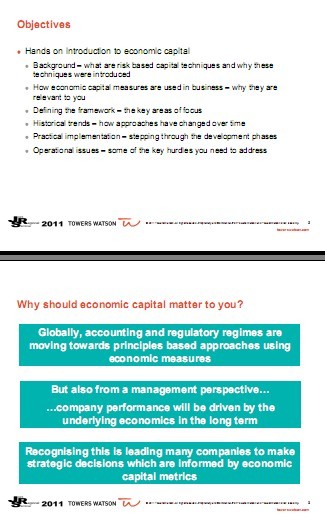Joint Regional Seminars(143页)PPT.rar
已下载:0 次 是否免费: 否 上传时间:2012-02-03

Objectives
Hands on introduction to economic capital
Background – what are risk based capital techniques and why these
techniques were introduced
How economic capital measures are used in business – why they are
relevant to you
Defining the framework – the key areas of focus
Historical trends – how approaches have changed over time
Practical implementation – stepping through the development phases
Operational issues – some of the key hurdles you need to address
Why should economic capital matter to you?
Globally, accounting and regulatory regimes are
moving towards principles based approaches using
economic measures
But also from a management perspective…
…company performance will be driven by the
underlying economics in the long term
Recognising this is leading many companies to make
strategic decisions which are informed by economic
capital metrics
Objectives
Introducing and defining capital
Different approaches used for different purposes
What are risk based capital techniques
Why these techniques have been introduced
What is capital?
Capital = assets – liabilities
Required capital = capital required to
support the business written
Regulatory required capital
Rating agency required capital
Internal required capital
Available capital = capital available
to support the business written
ssets
Available
capital
Required
capital
Free
capital
Technical
provisions
Why do companies hold capital?
Holding capital to support the business is a regulatory requirement…
…and it’s also essential for managing the business
Risk Capital
Risk exposure determines
capital needs
Required capital is a function
of the tail of the risk
distribution

 立即下载
立即下载 立即收藏
立即收藏